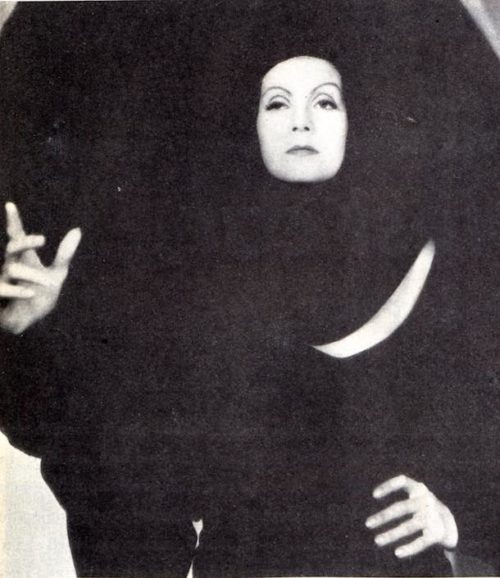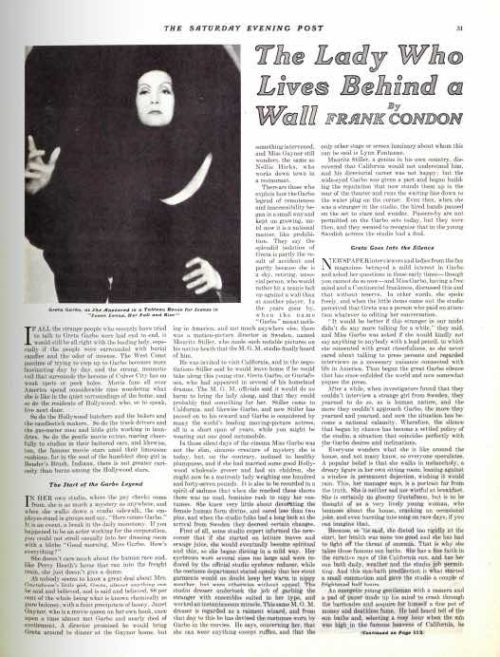Greta Garbo, Revealed
Originally published March 26, 1932.
Greta Garbo was one of Hollywood’s most talented and beautiful actresses — and one of its most reclusive stars. This 1932 article offered a peek behind the veil.

The West coast Pastime of trying to step up to Garbo becomes more fascinating day by day, and the strong, monastic veil that surrounds the heroine of cuLver city has no weak spots or peek holes. Movie fans all over America spend considerable time wondering what she is like in the quiet surroundings of the home, and so do the residents of Hollywood, who, so to speak, live next door.
In her own studio, where the pay checks come from, she is as much a mystery as anywhere, and when she walks down a studio sidewalk, the employees stand in groups and say, “Here comes Garbo.” It is an event, a break in the daily monotony. If you happened to be an actor working for the corporation, you could not stroll casually into her dressing room with a blithe “Good morning, Miss Garbo. How’s everything?” She doesn’t care much about the human race, and like Percy Heath’s horse that ran into the freight train, she just doesn’t give a damn.
There are those who explain how the Garbo legend of remoteness and inaccessibility began in a small way and kept on growing, until now it is a national matter, like Prohibition. They say the splendid isolation of Garbo is partly the result of accident and partly because she is a shy, retiring, unsocial person who would rather hit a tennis ball up against a wall than at another player. In the years gone by, when the name “Garbo” meant nothing in America, and not much anywhere else, there was a motion-picture director in Sweden, named Mauritz Stiller, who made such notable pictures on his native heath that the M-G-M studio heard of him.
He was invited to visit California, and in the negotiations Stiller said he would leave home if he could take along this young star, Greta Garbo, or Gustafsson, who had appeared in several of his homeland dramas. The M-G-M officials said it would do no harm to bring the lady along and that they could probably find something for her. Stiller came to California, and likewise Garbo, and now Stiller has passed on to his reward and Garbo is considered by many the world’s leading moving-picture actress, all in a short span of years, while you might be wearing out one good automobile.
In those silent days of the cinema Miss Garbo was not the slim, sinuous creature of mystery she is today but, on the contrary, inclined to plumpness. She knew very little about decorating the female human form divine, and cared less than two pins, and when the studio folks had a long look at her, they decreed certain changes.
First of all, some studio expert informed the newcomer that if she started on lettuce leaves and orange juice, she would eventually become spiritual and thin, so she began dieting in a mild way. Her eyebrows were reduced by the official studio eyebrow reducer, while the studio dresser undertook the job of garbing the stranger with ensembles suited to her type, working an instantaneous miracle. This same M-G-M dresser is regarded as a raiment wizard, and from that day to this he has devised the costumes worn by Garbo in the movies. He says, concerning her, that she can wear anything except ruffles and that the only other stage or screen luminary about whom this can be said is Lynn Fontanne.
Creation of A Legend
Mauritz Stiller, a genius in his own country, discovered that California would not understand him, and his directorial career was not happy; but the wide-eyed Garbo was given a part and began building the reputation that now stands them up in the rear of the theater and runs the waiting line down to the water plug on the corner. Even then, when she was a stranger in the studio, the hired hands paused on the set to stare and wonder. Passersby are not permitted on the Garbo sets today, but they were then, and they seemed to recognize that in the young Swedish actress, the studio had a find.
Newspaper interviewers and ladies from the fan magazines betrayed a mild interest in Garbo and asked her questions in these early times — though you cannot do so now — and Miss Garbo, having a free mind and a Continental frankness, discussed this and that without reserve. In other words, she spoke freely, and when the little items came out, the studio perceived that Greta was a person who paid no attention whatever to editing her conversation.
“It would be better if this stranger in our midst didn’t do any more talking for a while,” they said, and Miss Garbo was asked if she would kindly not say anything to anybody with a lead pencil, to which she consented with great cheerfulness, as she never cared about talking to press persons and regarded interviews as a necessary nuisance connected with life in America. Thus began the great Garbo silence that has since enfolded the world and now piques the press.
After a while, when investigators found that they couldn’t interview a strange girl from Sweden, they yearned to do so, as is human nature, and the more they couldn’t approach Garbo, the more they yearned and yearned, and now the situation has become a national calamity. Wherefore, the silence that began by chance has become a settled policy of the studio, a situation that coincides perfectly with the Garbo desires and inclinations.
Everyone wonders what she is like around the house, and not many know, so everyone speculates. A popular belief is that she walks in melancholy, a dreary figure in her own sitting room, leaning against a window in permanent dejection, wishing it would rain. This, her manager says, is a portrait far from the truth. She is neither sad nor wistful at breakfast. She is certainly no gloomy Gustafsson but is to be thought of as a very lively young woman who bounces about the house, cracking an occasional joke and even bursting into song on rare days, if you can imagine that.
Garbo’s dresser at the studio is the man who knows more about her than any other, and is he pestered to death with questions? He is, but he answers none of them. They say she thinks Polly Moran is a scream and would rather look at a film showing Polly at her capers than contemplate the noble film stories of high-minded directors and heavy stars. She has a manager who realizes that as long as 300 correspondents in Hollywood yearn to interview Garbo, all will be well, especially if the 300 are not permitted to do so. The feeling now is that if someone wrote a brilliant play for her, or even an ordinary play, Garbo could leave town and pack every theater in the United States, selling out in advance and collecting either $1 or $2 million dollars. As long as this potential million lies in the hollow of the hand, the yearning 300 will continue to find the Garbo wall high and rough and thick, and the eager public will have to be content with such minor bits as that she likes vanilla ice cream, has a few unimportant moles, rides on roller coasters, owns a parrot, likes cats, dislikes stockings, eats bread crusts, wonders what Amos ‘n’ Andy are talking about, weighs 122 pounds, avoids strangers, puts on her left shoe first, sits cross-legged, sees better with the right eye, loathes parties and takes a sun bath daily, with an inquiring eye on the hedge.

This article and other features about the stars of Tinseltown can be found in the Post’s Special Collector’s Edition, The Golden Age of Hollywood. This edition can be ordered here.